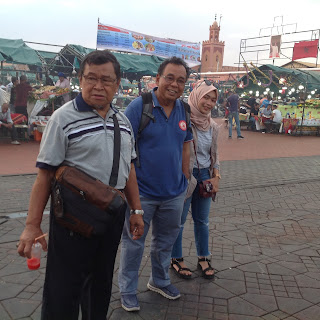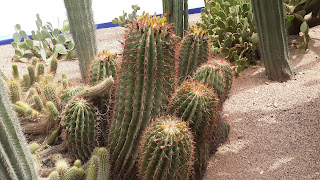9.9.2017 (Saturday) - 16.9.2017 (Saturday)
Residence Amina of Rue Ibn Oudari, Hivernage. Its a 2 bedroom apartment with full kitchen on 2nd floor with lift. We use this time share unit with 2016 allocation which we booked on 30th December 2016, 9 months in advance!.
Hivernagera is a wealthy residential district, is all
about private houses and large chain hotels. Amina Residence is stuck within it. It used to be a private residence.
 |
| the kitchen |
 |
| the bed is quite high |
 |
| sitting area |
 |
| another small room with 2 single beds.. pun tinggi |
 |
| View from the apartment with High Atlas Mountain |
 |
| view of nearby fruit orchard from the apartment |
A trip to nearby CarreFour for a week supply of groceries, we eat in most days.
 |
| Love Moroccan Zamzani honey |
 |
| if you cannot live without rice, better bring your own.. MAHAL giler! |
 |
| fruits in season.... sedap dan manis. Bring your grocery bag ok. |
 |
| Desert landscape on nearby building |
 |
| beautiful landscape in Hivernage (an up market section of the city) |
 |
| rows and rows of olive trees in Hivernage |
 |
| love the peaches and grapes.... murah pulak tu |
Since the temperature is not hot or cold, it is nice to stroll along the wide boulevards, typical of French streets or avenues.
 |
| Avenue Mohamad VI |
 |
| Gare (Railway Station in French) |
Magical Marrakech
This vibrant city is surrounded by palm-groves and olive gardens and bordered by the often snow-capped peaks of the High Atlas Mountain. With its colourful souks, time honoured masjids, ornate mausoleums, magnificent palaces and lively night time bustle on the Djemma el Fna, the 1,000 years old city is a sight to behold.
At times daunting, occasionally maddening, always
exhilarating, Marrakech is all about getting lost, letting go and opening up to
whatever experience or encounter comes your way. This should include diving
into the madness of Jemaa el Fna at night and eating at the food stalls.
Marrakech is divided into the medina (the old town) and
Guéliz (the Ville Nouvelle or new town).
Central Medina This is the geographical heart, spiritual
soul and tourist hub of the medina. Everything in this area – demarcated at its
southern end by the gardens of the Koutoubia and at its northern edge by Rue
Dar el Bacha – revolves like a whirlpool around the iconic Jemaa el Fna with
its ancient nightly spectacle. The souks stretch north of the square, and the
magnificent Koutoubia Mosque at the neighbourhood’s western edge stands
sentinel over the whole of Marrakech.
Southern Medina The grandest part of the medina, this
southern neighbourhood has a colourful cultural history and is where you’ll find
many of the city’s most chic riads. Made up predominantly of the original
fortified kasbah, the royal palace and the Mellah (Jewish quarter) with its
colourful markets, the area is punctuated by the great imperial palaces of
Marrakech, some wonderful museums celebrating the city’s heritage, the
legendary Mamounia hotel and the Agdal Gardens, where Marrakchis picnic in
summer.
Northern Medina Far from the mania of the souks, the
northern triangle of the medina is, for the most part, refreshingly undiscovered.
Traditional, tranquil residential life is played out around the tomb of
Marrakech’s most revered patron saint, Sidi Bel Abbes; vintage-lovers can spend
hours exploring the chaotic rambling flea market of Souk el Khemis; south,
closer to the souks, are galleries, fondouks, boutique shops, romantic riad
restaurants, a scattering of tailor’s shops and hammams, and the atmospheric
Madrassa Ben Youssef.
Guéliz Often undeservedly overlooked, super-relaxed Guéliz
(the new town or Ville Nouvelle as it is known) has some of the best and most
varied restaurants in town – from sushi and Thai to Lebanese, Italian and
French. Its leafy side streets are dotted with charming shops where everything
has a price tag and there is no need to haggle; fantastic modern art galleries
showcasing Moroccan and international artists; outdoor cafés that are great for
people-watching, and Yves Saint Laurent’s Jardin Majorelle, a breathtaking
sanctuary in the heart of the city.
City walls and gates
The ramparts of Marrakech which stretch for 19 km around the medina, were built by the Almoravids in 1070's as protective fortifications.
The walls are made of distinct orange-red clay and chalk, giving the city its nickname as the 'red city', it stand up to 19 feet high and have 20 gates and 200 towers along them.
The Souks and the Medina
Marrakech has the largest traditional Berber market in Morocco. A honeycomb of intricately connected alleyways, this fundamental secction of the old city ia a micro-medina in itself, comprising a dizzying number of stalls and shops that range from itsy kiosks no bigger than an elf's wardrobe to scruffy store-fronts that morph into glittering Aladdins Caves once you are inside.
Historically the souks of Marrakech were divided into retail area for leather, carpets, metalwork and pottery. Haggling is a very important part of trade in the souks.
Souk Semmarine (one of the largest) sells everything from brightly coloured bejewelled sandals and slippers and leather pouffes to jewellery and kaftans.
Souk Ableuh specialize in lemons, chillies, capers, pickles, green red and black olives, mint and tea.
Souk Kchacha specializes in dried fruits and nuts, dates, figs, walnuts, cashews and apricots.
 |
| floss you teeth? |
 |
| lip gloss every one? |
 |
| weaving for a livelihood |
 |
| getting lost in the medina |
Masjid Koutoubia
Koutoubia Mosque is the largest mosque in the city, located
in the southwest medina quarter of Marrakesh alongside the square. It was
completed under the reign of the Almohad Caliph Yaqub al-Mansur (1184–1199),
and has inspired other buildings such as the Giralda of Seville and the Hassan
Tower of Rabat. The mosque is made of red stone and brick and measures 80
metres (260 ft) long and 60 metres (200 ft) wide. The minaret was designed to
prevent a person at the top of the tower from viewing activity within the
king's harems. The Umayyad-style minaret is constructed from sandstone and
stands 77 metres (253 ft) high. It was originally covered with Marrakshi pink
plaster, but in the 1990s experts opted to remove the plaster to expose the
original stone work. The spire atop the minaret is decorated with gilded copper
balls that decrease in size towards the top, a style unique to Morocco.
The Koutoubia Gardens are situated behind the Koutoubia
Mosque. They feature orange and palm trees, and are frequented by storks. The
Mamounia Gardens, more than 100 years old and named after Prince Moulay Mamoun,
have olive and orange trees as well as a variety of floral displays.


Djemma el Fna
The Jemaa el-Fnaa is one of the best-known squares in Africa
and is the centre of city activity and trade. It has been described as a
"world-famous square", "a metaphorical urban icon, a bridge
between the past and the present, the place where (spectacularized) Moroccan
tradition encounters modernity. It has been part of the UNESCO World Heritage
site since 1985. The name roughly means "the assembly of trespassers"
or malefactors. Jemaa el-Fnaa was renovated along with much of the Marrakech
city, whose walls were extended by Abu Yaqub Yusuf and particularly by Yaqub
al-Mansur in 1147–1158. The surrounding mosque, palace, hospital, parade ground
and gardens around the edges of the marketplace were also overhauled, and the
Kasbah was fortified. Subsequently, with the fluctuating fortunes of the city, Jemaa
el-Fnaa saw periods of decline and renewal. Historically this square was used
for public decapitations by rulers who sought to maintain their power by
frightening the public. The square attracted dwellers from the surrounding
desert and mountains to trade here, and stalls were raised in the square from
early in its history. The square attracted tradesmen, snake charmers
("wild, dark, frenzied men with long disheveled hair falling over their
naked shoulders"), dancing boys of the Chleuh Atlas tribe, and musicians
playing pipes, tambourines and African drums. Richard Hamilton said that Jemaa
el-Fnaa once "reeked of Berber particularism, of backward-looking,
ill-educated countrymen, rather than the reformist, pan-Arab internationalism
and command economy that were the imagined future. Today the square attracts
people from a diversity of social and ethnic backgrounds and tourists from all
around the world. Snake charmers, acrobats, magicians, mystics, musicians,
monkey trainers, herb sellers, story-tellers, dentists, pickpockets, and
entertainers in medieval garb still populate the square.
Saadian Mausoleum
The Saadian Tombs were built in the 16th century as a
mausoleum to bury numerous Saadian rulers and entertainers. It was lost for
many years until the French rediscovered it in 1917 using aerial photographs.
The mausoleum comprises the corpses of about sixty members of the Saadi Dynasty
that originated in the valley of the Draa River. Among the graves are those of
Saadian sultan Ahmad al-Mansur and his family; al-Mansur buried his mother in
this dynastic necropolis in 1590 after enlarging the original square funeral
structure. It is located next to the south wall of the Almohad mosque of the
Kasba, in a cemetery that contains several graves of Mohammad's descendants.
His own tomb, richly embellished with decorations, was modeled on the Nasrid
mausoleum in Granada, Spain. The building is composed of three rooms; the best
known has a roof supported by twelve columns and encloses the tomb of
al-Mansur's son. The room exemplifies Islamic architecture with floral motifs,
calligraphy, zellijand carrara marble, and the stele is in finely worked cedar
wood and stucco. Outside the building are a garden and the graves of soldiers
and servants.
 |
| Route to the tomb, along narrow alley |
Jardins Majorelle
The Majorelle Garden, on Avenue Yacoub el Mansour, was at
one time the home of the landscape painter Jacques Majorelle. Famed designer
Yves Saint Laurent bought and restored the property, which features a
steleerected in his memory, and the Museum of Islamic Art, which is housed in a
dark blue building. The garden, open to the public since 1947, has a large
collection of plants from five continents including cacti, palms and bamboo.
Bahia Palace
The Bahia Palace, set in extensive gardens, was built in the
late 19th century by the Grand Vizier of Marrakesh, Si Ahmed ben Musa
(Bou-Ahmed). Bou Ahmed resided here with his four wives, 24 concubines and many
children. With a name meaning "brilliance", it was intended to be the
greatest palace of its time, designed to capture the essence of Islamic and
Moroccan architectural styles. Bou-Ahmed paid special attention to the privacy
of the palace in its construction and employed architectural features such as
multiple doors which prevented passers-by from seeing into the interior. The
palace took seven years to build, with hundreds of craftsmen from Fes working
on its wood, carved stuccoand zellij. The palace is set in a two-acre (8,000
m²) garden with rooms opening onto courtyards. The palace acquired a reputation
as one of the finest in Morocco and was the envy of other wealthy citizens.
Upon the death of Bou-Ahmed in 1900, the palace was raided by Sultan Abd
al-Aziz.

 |
| long corridors with amazing blue green yellow tiles |
 |
| some similarities with AlHambra in Granada Spain |
Downtown Marrakech
Biasa duduk satu satu tempat seminggu dah cukup. But not Marrakech... one week is definitely not ENOUGH!!!






















































































No comments:
Post a Comment